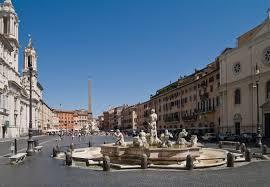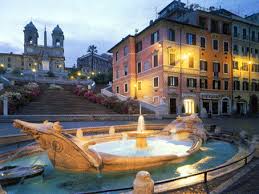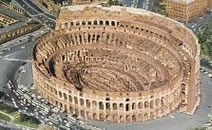This -Highlights of Rome is a superb introductory tour of Rome, ideal for first-comers.This tour takes you to the most important tourist sight in the centre of Rome. We suggest visit first :
Trevi Fountain, A fountain in the Trevi district in Rome, Italy. Standing 26.3 meters (86 ft) high and 49.15 meters (161.3 ft) wide, it is the largest Baroque fountain in the city and one of the most famous fountains in the world. A traditional legend holds that if visitors throw a coin into the fountain, they are ensured a return to Rome and we hope with us !! after we can move to.
 -Navona Square ,With its ornate fountains, baroque palazzi and colourful cast of street artists, hawkers and tourists, Piazza Navona is Rome’s most celebrated square. Built over the ruins of the 1st-century Stadio di Domiziano (Domitian’s Stadium), it is centred on Bernini’s showy Fontana dei Quattro Fiumi (Fountain of the Four Rivers), representing the rivers Nile, Ganges, Danube and Plate.
-Navona Square ,With its ornate fountains, baroque palazzi and colourful cast of street artists, hawkers and tourists, Piazza Navona is Rome’s most celebrated square. Built over the ruins of the 1st-century Stadio di Domiziano (Domitian’s Stadium), it is centred on Bernini’s showy Fontana dei Quattro Fiumi (Fountain of the Four Rivers), representing the rivers Nile, Ganges, Danube and Plate.
For almost 300 years from the time it was paved over in the 15th century, the piazza was home to Rome's main market. And while the market traders have long since gone the crowds continue to come to bask in its baroque beauty.
Of the piazza's three fountains, Bernini's high-camp Fontana dei Quattro Fiumi dominates. Depicting personifications of four great rivers, it's festooned with a palm tree, lion and horse and topped by an obelisk. Legend has it that the figure of the Nile is shielding his eyes from the Chiesa di Sant'Agnese in Agone, designed by Bernini's bitter rival, Borromini. The truth, more boringly, is that Bernini completed his fountain two years before his contemporary started work on the facade and the gesture indicates that the source of the Nile was unknown at the time.
Close to Navona square we can arrive in few minutes by car to the pantheon where after a quickly break to taste a really good roman “espresso”(cup of coffee short and strong)we finally arrive to the church.
Pantheon is a magnificent ancient temple in Rome that was later converted into the church of Santa Maria ad Martyres. Dating from 125 AD, this is the most complete ancient building in Rome and one of the city's most spectacular sights.
Until the 20th century, the Pantheon was the largest concrete structure in the world. Michelangelo studied its great dome before starting work on the dome of St. Peter's Basilica.
The Pantheon was dedicated to pan theos, "all the gods." When it became a church, it was dedicated to the Virgin Mary and all the martyrs.
After the Pantheon we can go to the heart of the city to look “The square”
 -Spanish Steps: the steps were built in 1723–26 by Francesco De Sanctis, not on behalf of the Spanish, but for the French as a grand entrée to their twin-towered church of Trinità dei Monti at the top. At the foot of the steps burbles the beloved Barcaccia ("Ugly Boat") fountain, a sinking and leaking marble boat sculpted by a teenage Bernini along with his father, Pietro Bernini . The less obvious, American connection to the Spanish Steps starts with the location of Rome's American Express office, a few doors south of the steps on the piazza In 1985, crowds thronged the piazza to protest the opening of Italy's first McDonald's here.
-Spanish Steps: the steps were built in 1723–26 by Francesco De Sanctis, not on behalf of the Spanish, but for the French as a grand entrée to their twin-towered church of Trinità dei Monti at the top. At the foot of the steps burbles the beloved Barcaccia ("Ugly Boat") fountain, a sinking and leaking marble boat sculpted by a teenage Bernini along with his father, Pietro Bernini . The less obvious, American connection to the Spanish Steps starts with the location of Rome's American Express office, a few doors south of the steps on the piazza In 1985, crowds thronged the piazza to protest the opening of Italy's first McDonald's here.
For some people the Spanish Steps are something to look at, go "ooh!", snap a photograph, and move on. Others insist that, since it is a staircase, it must be climbed; that'll take maybe 20 minutes up and down. Still others enjoy the easygoing vibe and sit on the steps for a while (though, sadly, authorities no longer allow you to picnic here—even to lick an ice cream cone). If you take time to soak it all in, visiting the Keats House and everything.
Now he we are at the end of the tour and we jump inside the history and the magnificent of roman empire arriving to the Roman Amphitheater.
 -The Colosseum Emperor Vespasian, founder of the Flavian Dynasty, started construction of the Colosseum in 72 AD. It was completed in 80 AD, the year after Vespasian's death.
-The Colosseum Emperor Vespasian, founder of the Flavian Dynasty, started construction of the Colosseum in 72 AD. It was completed in 80 AD, the year after Vespasian's death.
The huge amphitheater was built on the site of an artificial lake, part of Nero's huge park in the center of Rome which also included the Golden House (Domus Aurea) and the nearby Colossus statue. This giant statue of Nero gave the building its current name.
The elliptical building is immense, measuring 188m by 156m and reaching a height of more than 48 meters (159 ft). The magnificent structure was clad in marble and 160 larger-than-life statues graced the arches on the upper floors. Emperors used the Colosseum to entertain the public with free games. Those games were a symbol of prestige and power and they were a way for an emperor to increase his popularity.
Inauguration
Hundred-day games were held by Titus, Vespasian's successor, to mark the inauguration of the building in 80 AD. In the process, some 9,000 wild animals were slaughtered.
The southern side of the Colosseum was felled by an earthquake in 847. Parts of the building - including the marble cladding - were later used for the construction of other landmark buildings such as the St. Peter's Basilica and Palazzo Farnese.
Before to leave the Historical part of the town we can appreciate the overview of the
 Roman Forum, Latin Forum Romanum, most important forum in ancient Rome, situated on low ground between the Palatine and Capitoline hills. The Roman Forum was the scene of public meetings, lawcourts, and gladiatorial combats in republican times and was lined with shops and open-air markets. Under the empire, when it primarily became a centre for religious and secular spectacles and ceremonies, it was the site of many of the city’s most imposing temples and monuments. Among the structures surviving in whole or in part are the Temple of Castor and Pollux, the Temple of the Deified Caesar, the Mamertine Prison, the Curia (senate house), the Temple of Saturn, the Temple of Vesta, the Temple of Romulus, the Arch of Titus, the Arch of Septimius Severus, and the Cloaca Maxima.
Roman Forum, Latin Forum Romanum, most important forum in ancient Rome, situated on low ground between the Palatine and Capitoline hills. The Roman Forum was the scene of public meetings, lawcourts, and gladiatorial combats in republican times and was lined with shops and open-air markets. Under the empire, when it primarily became a centre for religious and secular spectacles and ceremonies, it was the site of many of the city’s most imposing temples and monuments. Among the structures surviving in whole or in part are the Temple of Castor and Pollux, the Temple of the Deified Caesar, the Mamertine Prison, the Curia (senate house), the Temple of Saturn, the Temple of Vesta, the Temple of Romulus, the Arch of Titus, the Arch of Septimius Severus, and the Cloaca Maxima.
The rates of the services includes: use of luxury vehicle,highway, and consumption feeds. Lunch, or entrance fees to the sites are not included.
Attention: the driver is not allowed to get OFF the limousine, but gives you historical/cultural information about the place you are visiting. The driver will wait for you in the car as long as you visit the several monuments.
All rates are quoted in the Euro and are only payable in the Euro currency at the end of the services or by banking account few days before the service.
Guides and entrance fees to the sites are not included.
Colosseum entrance tickets
with pre-reservation
€ 16,50 p.p